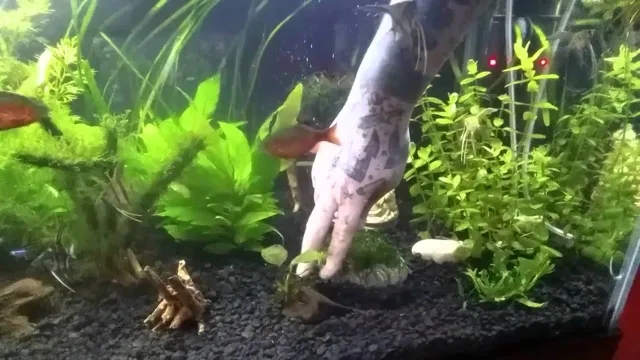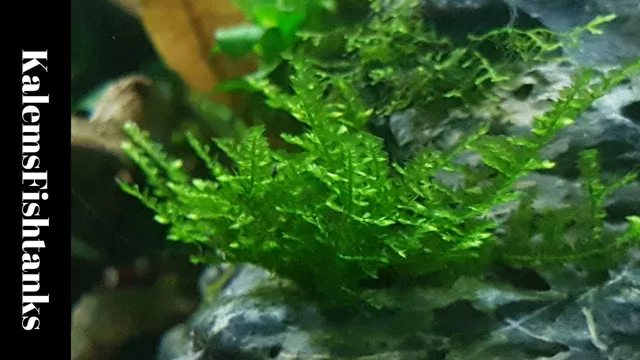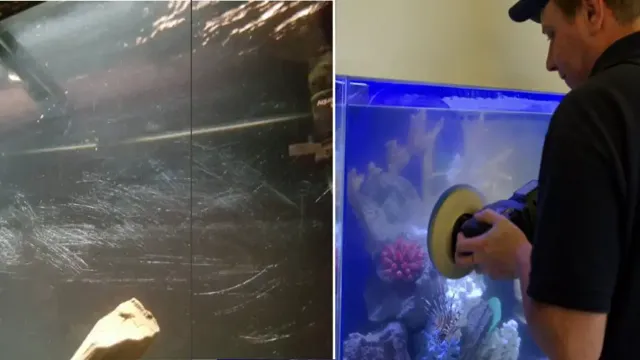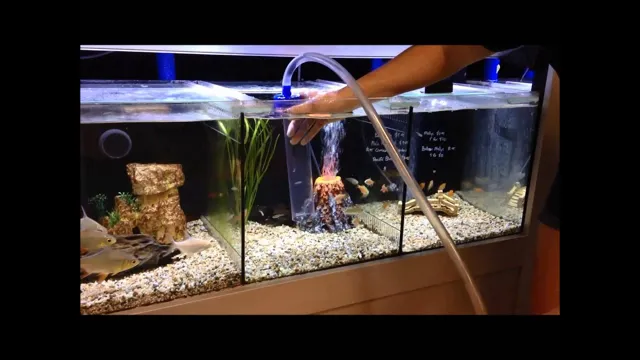How to Grow Moss for Aquarium: A Beginner’s Guide to Creating a Lush Aquatic Landscape

Have you ever wanted to create a lush and vibrant aquatic environment filled with beautiful moss? Moss is a common element in fish tanks, adding a natural and captivating appeal to any aquarium. However, growing moss for aquarium can be a challenging task if you don’t follow the right steps. Fear not, as we bring you a detailed step-by-step guide on how to grow moss for aquariums.
You’ll learn everything from selecting the right type of moss to preparing your tank for the growth process. Whether you’re an experienced aquarium enthusiast or a beginner, this guide will equip you with all the essential information you’ll need to create a stunning moss-filled aquatic paradise. Get ready to dive into the world of moss, and let’s make your aquarium come to life!
Understanding Moss
If you’re looking for an easy way to add some natural beauty to your aquarium, growing moss is a great place to start. Moss is an aquatic plant that can thrive in a variety of conditions and requires minimal upkeep, making it a popular choice for aquarium enthusiasts. To grow moss in your aquarium, you’ll need to start by choosing the right type of moss for your tank.
Some popular options include Java moss, Christmas moss, and flame moss. Once you’ve selected your moss, you’ll need to attach it to a surface in your tank, such as rock or driftwood. This can be done using fishing line or a special glue made for aquarium use.
Over time, your moss will begin to spread and grow, providing a natural and beautiful addition to your aquarium. Plus, moss can help to filter the water in your tank and provide a natural hiding place for your fish. So if you’re looking for a simple way to add some beauty and functionality to your aquarium, give moss a try!
Properties of Moss
Moss is a type of plant that can grow in various environments, ranging from forests and woodlands to swamps and bogs. While it may seem simple and unassuming at first glance, moss possesses a range of unique properties that make it an interesting and important plant species. For one, moss is highly absorbent and can hold up to 20 times its weight in water, making it an essential component of many wetland ecosystems.
Additionally, moss contains a range of enzymes and organic compounds that make it useful in a variety of medicinal and cosmetic products. For those interested in gardening or landscaping, moss can also be a valuable addition to a garden or outdoor space, as it can help control erosion and add a touch of natural greenery to any area. Whether you’re a plant enthusiast or simply looking to learn more about the natural world around you, understanding the properties of moss is an important step in appreciating the beauty and diversity of life on our planet.

Benefits of Moss in Aquariums
When it comes to decorating an aquarium, many factors come into play, including the choice of plants to use. One type of plant that has become increasingly popular is moss, and for good reason. Moss provides numerous benefits to aquariums, both for aquatic life and the overall appearance of the tank.
Moss helps to keep the aquarium clean by absorbing excess nutrients, reducing algae growth, and providing shelter for small fish and invertebrates. It also adds a natural and aesthetically pleasing look to the aquarium, mimicking the natural habitats of fish. Understanding the benefits of moss in an aquarium will help you create a beautiful and healthy aquatic environment.
By incorporating this versatile and beneficial plant into your aquarium, you’ll create a thriving ecosystem for your aquatic friends to call home.
Choosing the Right Moss
Are you wondering how to grow moss for your aquarium? Choosing the right moss for your aquarium can make all the difference in the health and vitality of your aquatic environment. There are many varieties of moss to choose from, but not all are suitable for aquariums. Java moss, for example, is a popular choice due to its hardiness and easy-care nature.
It can attach to any surface and can thrive under a wide range of water conditions. Another option is Christmas moss, which is a slow grower but creates a beautiful, festive look with its branching fronds. Peacock moss is also a popular choice for its delicate, feathery appearance.
When choosing your moss, it’s important to consider the conditions in your aquarium, such as lighting, substrate, and water flow. By doing a little research and selecting the right moss, you can create a healthy and beautiful ecosystem for your aquatic friends.
Popular Moss Varieties for Aquariums
Choosing the right moss for your aquarium can be a bit overwhelming, especially with so many different varieties available. Some popular mosses include Java Moss, Christmas Moss, Flame Moss, and Weeping Moss. When selecting moss for your aquarium, consider the lighting and nutrient levels in your tank, as some varieties thrive in low light and others require higher levels of nutrients.
Additionally, think about the overall look you’re trying to achieve, as different mosses have varying textures and growth patterns. For example, Java Moss has a branching and tangled appearance, while Christmas Moss is more feathery and delicate. By taking these factors into account, you can select the perfect moss variety for your aquarium that not only looks stunning but also thrives in your specific tank conditions.
Factors to Consider When Choosing Moss for Aquariums
When it comes to choosing moss for your aquarium, there are a few factors to keep in mind. One important thing to consider is the light requirements of the moss – some species prefer low light conditions, while others thrive in brighter environments. It’s also important to think about the temperature and pH levels of your aquarium, as certain types of moss may not be able to handle extreme temperatures or highly acidic water.
Another factor to consider is the growth rate of the moss – if you want a lush, full appearance, you’ll want to choose a faster-growing species. Finally, think about the aesthetic qualities of the moss, such as its color and texture. Whether you want a bright green ground cover or a more nuanced, textured look, there is a type of moss out there that can meet your needs.
By taking the time to choose the right moss for your aquarium, you can create a beautiful, healthy environment for your fish and other aquatic creatures to thrive in. So, which moss will you choose for your aquarium?
Preparing to Grow Moss
If you want to add some lively greenery to your aquarium, then growing moss can be a fantastic addition. Not only does it bring some vibrant color to your aquarium, but it can also create a more natural environment for your aquatic pets. There are several types of moss that you can choose from, such as Java Moss or Christmas Moss.
However, before you start growing moss for your aquarium, you’ll need to ensure that you have the right setup. This includes providing enough lighting, ensuring that the water has the right nutrients, and creating the right temperature and pH balance. Once your tank is ready, you can start to add your moss, and in no time, you’ll see the growth starting to flourish.
By growing moss in your aquarium, you can create a beautiful underwater scene that your pets will love.
Gathering Materials
When preparing to grow moss, the first step is gathering the necessary materials. Moss needs a few basic requirements to thrive, such as moisture, shade, and a porous substrate to grow on. One of the most important things to consider when gathering materials is the location where the moss will be grown.
This will determine the type of substrate needed. For example, if growing moss on a tree, the substrate may be bark or wood chips, while if growing moss in a container, it could be soil or peat moss. Another important consideration is water.
Moss needs a consistent source of moisture to grow, so it is important to plan for regular watering. Collecting fallen leaves, small stones, and other natural materials can also be used to create a more natural-looking environment for the moss to grow in. By carefully gathering all of the necessary materials ahead of time, your moss-growing project is sure to be a success.
Creating the Right Environment for Moss
Growing moss requires a little effort, but it’s a rewarding experience that will result in a beautiful and calming green environment. Before you start, you need to prepare the area where you want to grow the moss. To do this, you must ensure that the area is free of weeds, leaves, and any other debris.
Soil pH levels also play a vital role in growing moss. Ideally, moss likes acidic soil with a pH level of around
If you have alkaline soil, you can make it more acidic by adding sulfur or peat moss. Moss can grow in different lighting conditions, from full shade to partial sun, but more shade is better because it conserves moisture. You may also consider installing a drip irrigation system to supply moisture consistently to the moss.
It would help if you kept the area moist during the growing period. Overall, creating the right environment for moss requires focus and attention to detail, but with time and effort, you will have a beautiful moss-covered space that you can enjoy for years to come.
Growing Moss
If you’re looking to add some greenery to your aquarium, growing moss is a great option. Moss not only adds a natural look to your tank but it also helps with water filtration and provides a hiding place for fish or other aquatic creatures. To grow moss in your aquarium, start by selecting the right type of moss.
Some popular options include Java moss, Christmas moss, and Willow moss, among others. Once you’ve chosen your moss, you can either attach it to a rock or substrate using a fishing line, mesh, or glue. It’s important to keep the moss moist and provide it with enough light (but not direct sunlight) to encourage growth.
Along with regular maintenance, such as trimming and removing dead leaves, consistent water quality, and temperature control are also important factors to keep in mind. With patience and care, you can enjoy a thriving and beautiful moss garden in your aquarium.
Attaching Moss to Substrates
Growing moss and attaching it to substrates can be a beautiful addition to any garden or indoor space. Moss is a low-maintenance plant that requires very little attention once established, making it an ideal choice for those who don’t have the time or patience for more high-maintenance plants. To attach moss to a substrate, you will need to create a suitable environment for it to grow, such as moist and shady conditions.
Once you have found the perfect location, moss can be attached to rocks, logs, or soil using a variety of methods. One of the most effective ways to attach moss to a substrate is using a mixture of yogurt and water, which acts as a natural adhesive. Alternatively, you can use a wire mesh or fishing line to secure the moss in place until it becomes established.
Regular misting and watering will help to encourage the growth of the moss, and over time, it will spread and cover the entire substrate, creating a beautiful and natural-looking addition to your garden or home. So why not give growing moss a try, and see how it can transform your living space into a serene and peaceful oasis.
Water Conditions and Lighting for Moss
Growing moss can be a challenge, but the reward of a lush and vibrant green area is worth it. To ensure optimal growth, it’s important to pay attention to water conditions and lighting. Moss loves a moist environment, but be sure not to overwater as it can lead to rot.
Keep the soil damp but not saturated. As for lighting, moss prefers indirect or filtered light rather than direct sunlight as it can dry out the moss quickly. A great solution is to place moss in a shaded area with indirect light, or near a window with a sheer curtain to regulate the amount of sunlight.
Remember, moss is a delicate plant that requires minimal maintenance, so be sure to monitor and adjust water and light as needed to achieve the best results. With a little bit of love and attention, you can create a stunning, thriving moss garden.
Maintenance and Care Tips for Moss
If you’re thinking of growing moss, you’re in for a treat. Moss is not only beautiful and unique, but it’s also remarkably easy to care for. One of the reasons why moss is so low-maintenance is that it doesn’t require any fertilizers or pesticides.
In fact, it prefers a natural, organic environment. This makes it an ideal addition to any garden or indoor space. To grow moss, you’ll need to choose the right location.
Moss thrives in a damp, shaded area, such as under a tree or along a garden path. Once you’ve found the perfect spot, clear away any debris or stray plants that might be blocking the sunlight. Then lightly mist the area with water and add a layer of organic soil.
Finally, add the moss in small clumps, being careful not to press it down too hard. With a little patience and care, your moss will flourish into a beautiful, green carpet.
Troubleshooting Moss Growth Issues
Growing moss for aquariums is a unique and rewarding hobby that can quickly turn into a nightmare if not done right. It’s not uncommon for moss to begin to grow on the surface of the water or other areas of the aquarium, and this can be a sign that something is off with the water quality. To grow moss successfully, you need to provide the perfect environment, which involves ensuring the water has the right pH level and is not too hard or soft.
It’s also important to monitor the lighting and water temperature because these factors can affect the growth of moss. One other issue that can arise is unwanted moss growth overtaking other plants in your aquarium. To prevent this from happening, it’s vital to keep your aquarium well-maintained and to remove any excess growth on a regular basis.
Overall, with the right knowledge and care, growing moss can add a striking touch to your aquarium while helping to create a natural ecosystem for your fish.
Common Issues with Growing Moss in Aquariums
Moss is a popular plant among aquarium hobbyists because of its ability to add a natural touch to any underwater landscape. However, growing moss is not always an easy task. Some common issues arise when maintaining a mossy aquarium, such as insufficient lighting or carbon dioxide levels.
If you find that your moss is turning brown or yellow, it may be a sign that your lighting is not strong enough. Another issue could be due to inadequate carbon dioxide, which can be rectified by adding a CO2 injector. If you notice that your moss is not attaching itself to surfaces, you may need to be patient.
It can take weeks for moss to attach itself and start growing. Additionally, if you have too much algae growth, it may be competing with the moss for nutrients and light. In this case, reducing the amount of light and providing proper nutrients can help resolve the issue.
Overall, growing moss requires patience and tending, but with proper care, it can add a beautiful touch of green to any aquarium.
Solutions to Moss Growth Issues
If you’re struggling with moss growth issues, don’t worry, there are solutions. The first step in troubleshooting is identifying the underlying cause. Often, moss thrives in moist and shady areas, so it’s important to ensure adequate drainage and sunlight.
If there are areas that are consistently damp, try improving drainage by adding sand or gravel. Trimming overgrown trees or shrubs can also allow more sunlight to penetrate and prevent moss from growing. Additionally, adjusting watering schedules or reducing overwatering can help.
If the soil is too acidic, consider adding lime to raise the pH level. Finally, physically removing moss by hand or with a rake can be effective, but be careful not to damage the underlying grass or plants. By taking a few simple steps, you can prevent and manage moss growth issues in your outdoor spaces.
Conclusion: Enjoying the Beauty of Moss in Your Aquarium
In conclusion, growing moss for your aquarium can be a fun and rewarding experience. Moss not only adds aesthetic appeal to your tank, but also provides a safe and comfortable environment for your fish to thrive. Whether you choose to go the traditional route of tying your moss to rocks and driftwood, or opt for more modern methods such as using mesh or glue, one thing is for sure: with a little bit of patience and dedication, you can become a master moss-grower in no time.
So, let your creativity flow and watch as your moss-covered aquarium becomes the envy of fellow fish-enthusiasts!”
FAQs
What is the best type of moss for aquariums?
Java Moss and Christmas Moss are popular choices for aquariums due to their hardy nature and ability to grow in a variety of water conditions.
Can moss grow without CO2 injection in planted aquariums?
Yes, moss can grow without CO2 injection in planted aquariums, but it may grow more slowly and less densely.
How do you attach moss to aquarium decorations?
You can attach moss to aquarium decorations using fishing line, super glue gel, or aquarium safe silicone adhesive.
Why is moss beneficial for aquariums?
Moss is beneficial for aquariums because it provides shelter and hiding places for fish and shrimp, and also helps to regulate the water quality by absorbing excess nutrients.
Do moss carpets require special lighting?
Moss carpets do not require special lighting. However, using a high-intensity light will encourage thicker and faster growth.
How do you prune moss in an aquarium?
To prune moss in an aquarium, simply trim back any overgrown or excess growth with scissors or tweezers.
How long does it take for moss to establish in an aquarium?
Moss can take several weeks to establish in an aquarium, but once it takes hold, it will grow steadily and may require pruning to keep under control.






